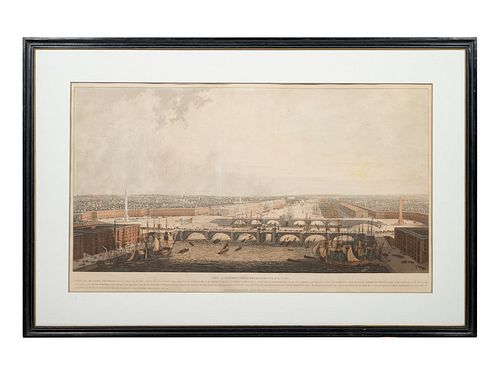View of London with the Improvements of its PORT, Daniell, Dance, aquatint, 1802
About Auction
Feb 27, 2025 - Mar 30, 2025
Impressionist & Modernist Paintings & Drawings. Important early Modernists: Picasso, Lautrec, Leger, Degas, Jawlensky, Matisse, Cortez, Kandinsky, Klee, Thomas Hart Benton, Offers welcome. Also: Jewelry, Sculpture & Furniture King Art & Antiques kking15259@aol.com
- Lot Description
View of London, with the Improvements of its PORT: submitted to the Select Committee of the Honourable House of Commons, by Mr Dance, exhibiting the proposed Double Bridge intended for the passage of Ships Published: 15 August 1802 , London Formats: Hand-colored Aquatint Creator: William Daniell (British, 1769–1837) Image: 388 by 770mm (15.25 by 30.25 inches). Sheet: 21.5 by 35 inches. Sight: 17 1/4 x 30 1/2 inches Published as the Act directs for William Daniell No.9 Cleveland Street Fitzroy Square, Aug. 15, 1802., London,, 1802 Appears to have been conserved previously. IF PURCHASED OVERSEAS ITEM WILL BE SHIPPED WITHOUT FRAME This aquatint in the depicts the Thames at the City of London from a bird’s eye perspective. It was produced and published in 1802 by the English landscape painter William Daniell (1769–1837), after his own painting exhibited at the Royal Academy that year. Daniell’s work visualises a design for a new London Bridge by George Dance the Younger (1741–1825), architect and surveyor to the Corporation of London. Dance’s father had overseen the removal of the medieval houses which lined the sides of the Old London Bridge. Having trained under him, the architect was responsible for renovating the dank and redundant marshland around Blackfriar’s with a system of new roads. The younger Dance had a personal interest in this area of London, so when a Parliamentary Select Committee announced a competition for designs to rebuild the bridge in April 1800, the architect was keen to submit a proposal. Dance’s creation is shown in the foreground: two stone bridges run parallel to each other, each with a towered drawbridge at center which could be raised to allow river traffic to pass. The purpose of a twin bridge, as Daniell explains in the subtitle to his aquatint, was to facilitate pedestrian movement at all times. ‘By the alternate elevation of a draw bridge in either of the two bridges’ an ‘uninterrupted way over the other is afforded at all times for carriages and foot-passengers’, he writes. In his scheme Dance proposed a crescent-shaped piazza at the south end of the bridge. This was to mirror the existing and ‘extensive amphitheatrical area on the north side of the Thames’, at the center of which stood Sir Christopher Wren’s Monument to commemorate the Great Fire of London. The fluted Doric column topped with a gilded urn can be seen at left. As a focal point of the southern semi-circular piazza, Dance designed a grand obelisk topped with a ‘Naval Trophy’. Dance also planned to remodel the Embankment, enlarge the Legal Quays (authorized wharves on the Thames), and build a new customs house and a series of warehouses that would extend right the way down to the Tower of London. This transformation of the northern embankment, Dance hoped, would enable goods to be ‘conveyed by carts’ overland rather than by boat which would add further traffic to the already congested Thames. In the event the architect’s design was not realized. Its Venetian-inspired grandeur came at the eye-watering price of £1.25 million. It was nonetheless praised as a splendid design, worthy of being commemorated and exhibited in a painting by Daniell and in subsequent prints https://www.bl.uk/collection-items/view-of-london-with-the-improvements-of-its-port
Condition
“Appears conserved, edge tears, edge toning, flattened fold, minor paper wanting margins, minor frame damage”
- Shipping Info
-
Shipping within the contingent USA is not included in the sales price except listed otherwise. Any overseas shipping will be negotiated between buyer and seller and paid by buyer. Shipping will be insured and shipping is on Monday & Tuesday to avoid over the weekend storage in transit warehouse
-



 EUR
EUR CAD
CAD AUD
AUD GBP
GBP MXN
MXN HKD
HKD CNY
CNY MYR
MYR SEK
SEK SGD
SGD CHF
CHF THB
THB






